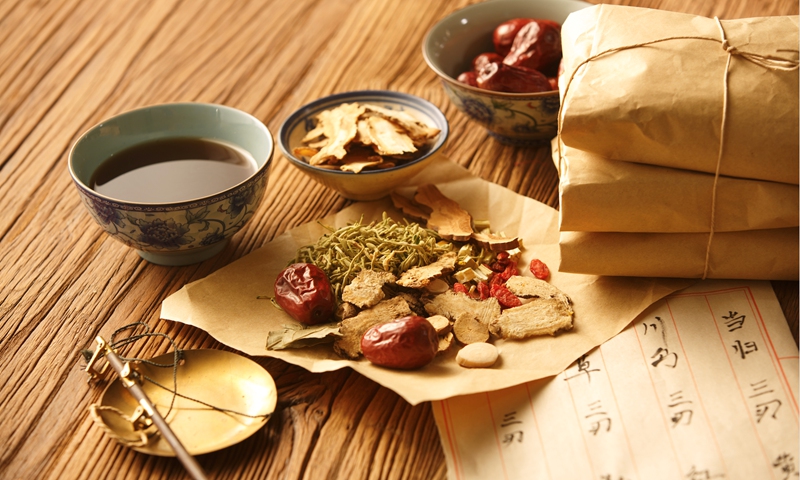
Traditional Chinese medicine plays an important role in disease prevention, treatment and control. It can not only treat diseases but also work as a tonic. It even assists the treatment for coronavirus and has a positive function while coordinated with Western medicine.
Gaofang
With the onset of winter, it is the season to take gaofang.
According to traditional Chinese medicine concepts, taking gaofang can enhance health, especially for those with weak immunity and chronic diseases.
Tuesday is marked as dongzhi, or winter solstice, under the Chinese lunar calendar. It is the time when people start to consume gaofang, which is taken every day until spring arrives.
Under TCM theory, winter is the best time to consume tonics for health improvement.
While other hospitals hire pharmaceutical companies to produce gaofang, Shanghai Yueyang Hospital of Integrated Traditional Chinese and Western Medicine is the only one in the city to sustain traditional means by having a special plant with 100 copper vessels to make the tonic itself.
This year, it moved its vessels into a new two-story gaofang center, which consists of a gaogang plant and a gaofang museum to promote TCM culture. The hospital has organized residents to visit the center to have a close view about how gaofang is produced, and learn TCM knowledge from professionals.
Gaofang is a herbal paste made of condensed liquid herbal medicines chock full of ingredients like honey and brown sugar. Each paste is tailor-made according to a doctor’s prescription.
Yueyang has more than 40 years of gaofang prescription and production.
“Our hospital has made about 20,000 gaofang prescriptions this year,” said Zhu Xiaochun of the hospital’s department of pharmacy.
“We can product about 400 gaofang each day. While gaofang has become a product of assembly lines in many factories and pharmacies, we insist in adhering to the handmade practice through traditional skills and process. Copper vessels are the soul of the process, as it has been passed from generation to generation.”
With 100 vessels being heated, it is 70 to 80 degrees Celsius inside the boiling workshop.
Traditional gaofang production consists of seven stages – formula, soaking, extracting, concentrating, collecting, packaging and drying.
“The herbal materials must be soaked for six hours and boiled for three hours,” said Huang Qianyuan, a pharmacist working at the gaofang plant. “The steps are strictly monitored and done precisely to ensure gaofang quality.
“The whole production process of each gaofang requires two days.”
To meet people’s demand, the hospital offers packages of gaofang in a traditional vessel or small plastic bags, which contains daily dosages.
Acupoint injection
Winter is also the peak season for respiratory diseases.
At the ear, nose and throat department of Shanghai Hospital of Traditional Chinese Medicine, patients with allergic rhinitis, chronic sphagitis and tinnitus are gathering to wait for acupoint injection and moxibistion as well as acupuncture therapy.
Acupuncture is a skill of traditional Chinese medicine while needle injection is a typical Western medical practice. Acupoint injection is one of the perfect integrations of TCM and Western medicine.
Acupoint injection means doctors inject liquid medicine into specific acupoints to treat different diseases.
“We started to focus on acupoint injection for ear, nose and throat diseases in the early 1990s,” said Dr Guo Yu, a leading expert from the department.
“We choose the Tiantu point to do the injection, because Tiantu, which is located below the throat, is an intersection point of Ren Channel like a traffic hub connecting the airport, railway and metro lines. Injection into Tiantu can have better effects.”
Traditional Chinese medicine ascribes people’s body into eight channels. Ren Channel, which starts from the lower abdomen and ends at orbits, running through the center of the body. It is the center of qi (energy flow).
Tiantu itself mainly connects with throat diseases. Injecting this point can promote lung function and better respiration, Guo added.
Under western medical theory, Tiantu is below the thyroid and above thymus. Stimulating Tiantu can help generate people’s own immunity to fight against ear, nose and throat diseases and against infection.
“We also choose different liquid medicines in line with the patient’s condition and medical demand,” he said.
“So far, we have introduced acupoint injection for tens of thousands of patients to confirm its effects and safety. There have been no complaints or medical accidents.”
To find more evidence to support the treatment, Guo said his team is cooperating with the Shanghai General Hospital to carry out medical research on TCM and Western medical treatment for vocal leukoplakia. This is a white-plaque disease due to long-term stimulation of vocal cords due to infection and smoking. There is a risk of cancerous development.
“We are jointly studying the proper implication of TCM and Western therapy like surgery on different levels of the disease,” he said.
“In the early stage, TCM like acupoint injection and herbal soup is effective, while those at the terminal stage, we can introduce TCM as after-surgery supportive treatment.”
Yan Junping, a patient with pharyngitis, said he has taken Western medicines for a long term without positive effects and turned to Guo for acupoint injections.
“It is my second outpatient today,” he said. “My symptoms have improved.”